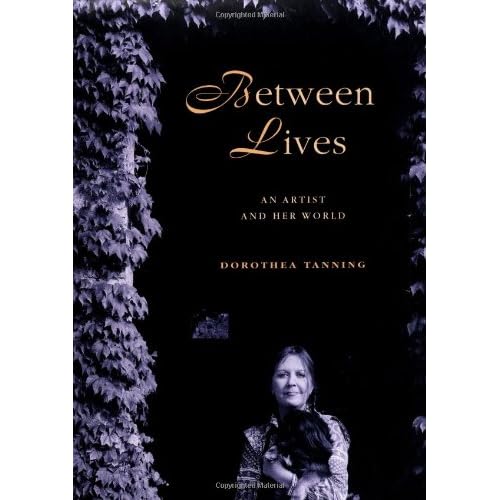Between Lives: An Artist and Her World
Category: Books,Arts & Photography,History & Criticism
Between Lives: An Artist and Her World Details
From Publishers Weekly A noted American artist born in Galesburg, Ill., Tanning lived in a milieu of European creativity as wife of the surrealist painter Max Ernst (1888-1976). Now in her 90s, she has expanded a previous memoir (Birthdays) to offer a fuller reminiscence. She is self-effacing, finding Ernst's life and story more interesting than her own, but describes their shared life poetically: "Yes, I think I was his house. He lived in me, he decorated me, he watched over me." While there are glimpses of other creative talents, like the composer-critic Virgil Thomson, who snoozed next to Tanning while supposedly reviewing a concert, Tanning is best on artists, like the oddball genius Joseph Cornell: " a modern Dante, with his deep religious feeling and physical abstinence. Consummate romantic in an intoxicatingly worldly world, he came frequently to town as from some remote monastic commune." Fans of name-dropping will melt at her wedding with Ernst, a double marriage with Mr. and Mrs. Man Ray, with Stravinsky offering the wedding toast. More noteworthy is Tanning's ready wit, as in the story of a French neighbor's cat who would wait till his master arrived home, then "jumps up on the table and urinates in his soup." Surviving the devastating loss of Ernst, she concludes: "By evening the pall has lifted. Everything waits, radiant. Life is okay." Few surrealists or those close to them would have such a sunny world view, but this vigorous optimism is part of Tanning's real charm, not to mention her ever-improving art and poetry, both of which arrived at a new level of achievement when she was already a senior citizen. Modern art lovers of multiple generations will want this book, as will universities with larger art history collections. Copyright 2001 Cahners Business Information, Inc. Read more From Library Journal In this memoir, an expansion of Birthday, her 1987 collection of reminiscences, Tanning recounts her life and work. A noted painter and sculptor, Tanning moved in a circle that included some of the 20th century's greatest creative presences. From the worlds of dance, music, and literature, Tanning remembers episodes with Virgil Thomson, George Balanchine, Dylan Thomas, and Truman Capote. Her own artistic milieu included Giacometti, Joseph Cornell, Joan Mir?, and her husband, the surrealist Max Ernst. Never merely gossipy or needlessly name-dropping, Tanning's memoir parades those she met and knew through New York, to New Mexico, to Paris, and back again, after Ernst's death, to New York. In her writing, Tanning achieves, at moments and sometimes for pages at a time, a prose style that is nearly, but not quite, lucid. Unfortunately, her maddeningly "poetic" account provides us with an obstructed view into the world of modern art. A worthwhile but not necessary purchase for collections with a modern art focus. Martin R. Kalfatovic, Smithsonian Institution Libs., Washington, DC Copyright 2001 Reed Business Information, Inc. Read more From Booklist Piquant and candid at 91, Tanning acknowledges that her art has been overshadowed by that of Max Ernst, her husband for 34 years, and her musings on how she feels about this form one of many compelling strands in her meditative reminiscence. Concerned more with psychological truths and ambience than with fact, Tanning uses language like paint, limning scenes dreamy in hue yet acute in detail and metaphoric in their images. A pretty and adventurous girl from Galesburg, Illinois, she took off solo for Chicago, then New York. When she met Ernst (51 to her 32) in 1942, she was painting and supporting herself with fashion illustration, a distraction Ernst freed her from as they embarked on a resilient partnership that took them to rugged Sedona, Arizona, and lovely France, where they painted and cultivated close friendships with fellow artists. Tanning tells marvelously vivid and resonant stories and describes the "never-ending hunt for revealment" that spurs her ongoing creativity. Donna SeamanCopyright © American Library Association. All rights reserved Read more Review “In buoyant and electric prose, laced with wit and leavened with ungrudging generosity, Dorothea Tanning has given us in this memoir a brilliant account of the fizz and panache of a truly remarkable life: Stravinsky provides her wedding champagne; at a Paris soirée, André Malraux upstages Orson Welles; J. Robert Oppenheimer turns up at Les Deux Magots; and the gentle and enigmatic surrealist Max Ernst, Ms. Tanning's husband, is the presiding spirit. This is a sustained success of recuperative magic.” - Anthony Hecht“It seems hardly fair that Dorothea Tanning, in a long, passionately inventive career as a painter, should have acquired as well the other harmony of prose, and that her passionate inventions as a writer should be so lovingly, so wisely resolved. Indeed it is not fair at all: the Muse was never an equal-opportunity employer, and the only appropriate response to Between Lives is untempered gratitude. How grateful I am for the Muse's caprice, twice over, for Dorothea Tanning is a dauntless writer who is entitled to love her life; she created it, and now, quite unfairly, I love it, too.” - Richard Howard Read more About the Author Dorothea Tanning's painting and sculpture rank among the most inventive of any living American artist. Her poetry has appeared in The New Republic, Partisan Review, and The Paris Review, among many other publications, and was included in The Best American Poetry 2000. She lives in New York City. Read more

Reviews
She was truely an American treasure and way before her time. This book gives some insight into her extraordinary life.


